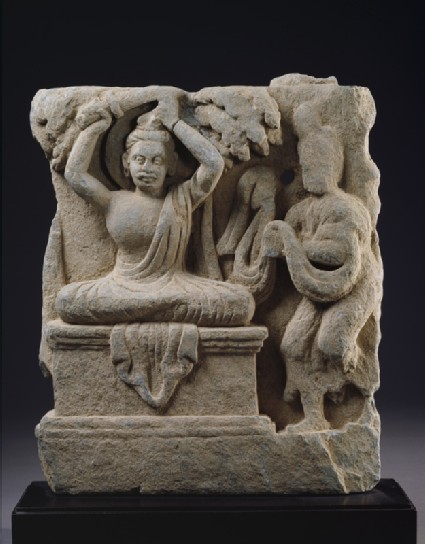Room 12 | India 2500 BC-AD 600 gallery
Explore the early development of Indian art, from the artefacts of the Indus Valley to the Hindu and Buddhist sculpture of north India and Gandhara.

Galleries : 31 objects
Show search help- Reference URL
Actions
Relief fragment depicting Prince Siddhartha, the future Buddha, cutting his hair in renunciation
-
Description
In this relief fragment, the prince uses a short sword to cut his hair, prior to becoming a wandering ascetic. The attendant receives his discarded turban.
-
Details
- Associated place
- Date
-
1st century AD (AD 1 - 100)
Kushan Period (AD 50 - 600)
- Associated people
-
the Buddha (active c. 560 BC - c. 486 BC) (subject)
- Material and technique
- schist
- Dimensions
- 29.5 x 25.3 x 4.2 cm max. (height x width x depth)
- Material index
- Technique index
- Object type index
- No. of items
- 1
- Credit line
- Purchased, 1997.
- Accession no.
- EA1997.246
-
Further reading
Quagliotti, Anna Maria, ‘A Gandharan Bodhisattva with Surya on the Headdress and Related Problems’, Maurizio Taddei and Giuseppe De Marco, eds, South Asian Archaeology 1997: Proceedings of the Fourteenth International Conference of the European Association of South Asian Archaeologists, 3 vols, Serie orientale Roma, 90 (Rome: Istituto italiano per l'Africa e l'Oriente, 2000), iii
Koizumi Yoshihide, ‘Study on the Portable Shrines in Northwest India’, Proceedings of the Tokyo National Museum, 35, (2000), fig. 43
Taddei, Maurizio, ‘Some Reflections on the Formation of the Buddha Image: Keynote Address’, Ellen M. Raven, ed., Proceedings of the Fifteenth International Conference of the European Association of South Asian Archaeologists, held at the Universiteit Leiden, 5-9 (Groningen: Egbert Forsten, 2008), pp. 3-4, illus. p. 5 fig. 1.3
Location
Objects are sometimes moved to a different location. Our object location data is usually updated on a monthly basis. Contact the Jameel Study Centre if you are planning to visit the museum to see a particular object on display, or would like to arrange an appointment to see an object in our reserve collections.
Galleries
Notice
Objects may have since been removed or replaced from a gallery. Click into an individual object record to confirm whether or not an object is currently on display. Our object location data is usually updated on a monthly basis, so contact the Jameel Study Centre if you are planning to visit the museum to see a particular Eastern Art object.
© 2013 University of Oxford - Ashmolean Museum



